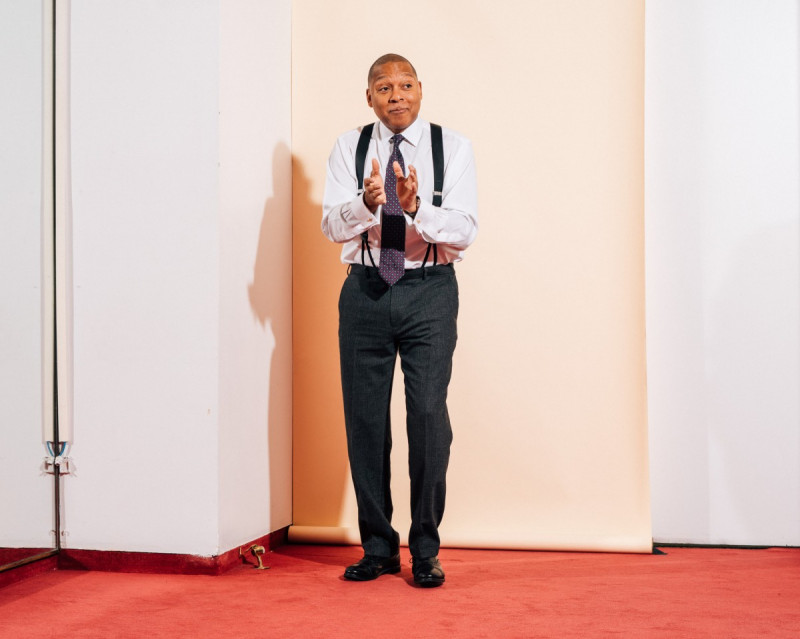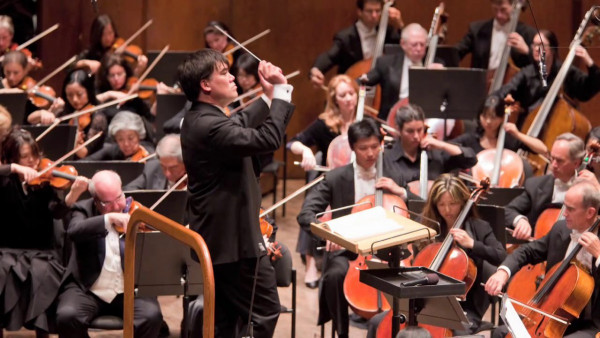Review: Wynton Marsalis’s Urban Symphony for the Philharmonic

(Photo by Cole Wilson for The New York Times)
The next time Wynton Marsalis writes a symphony for the New York Philharmonic, he might want to plan from the start to keep it well under an hour. At least if he wants to assure that the Philharmonic will be able to perform it complete.
Timing was a factor in 2010, when Alan Gilbert led the American premiere of Mr. Marsalis’s Symphony No. 3, “Swing Symphony,” on a season-opening gala program. Because it was being televised on “Live From Lincoln Center,” the concert had to come in under two hours. So Mr. Gilbert dropped the first of Mr. Marsalis’s six movements, which still left some 45 minutes of music. (The symphony was performed in full the following season, and then again, with yet another movement added, in 2013.)
On Wednesday at David Geffen Hall, Mr. Gilbert conducted the premiere of Mr. Marsalis’s Symphony No. 4, “The Jungle.” Because the score was so long and demanding and the rehearsal schedule so tight, the orchestra said, Mr. Gilbert and Mr. Marsalis agreed to skip the first of this symphony’s six movements. The remaining five still made for a substantial piece of 50 minutes.
The challenges of Mr. Marsalis’s orchestral works come not just from their length and demands, but from the defining character of the music, which strives to blend jazz, blues and swing into the classical symphonic realm. It’s difficult to fuse such contrasting styles, both for Mr. Marsalis as composer and the Philharmonic musicians. In “The Jungle,” Mr. Marsalis for the most part finds the sweet spot, despite stretches that come close to pastiche. As with his Third Symphony, it combines the Philharmonic and a complement of impressive musicians from the Jazz at Lincoln Center Orchestra, including Mr. Marsalis, playing trumpet with his usual brilliance.
“The Jungle” is a musical portrait of New York City, the “most fluid, pressure-packed, and cosmopolitan metropolis the modern world has ever seen,” as Mr. Marsalis writes in a program note. The opening “Big Show” movement evokes, he says, the “brash, brassy, razzle-dazzle of our city.” It starts with a call-to-attention fanfare, sputtering and slightly askew. There are hints of ragtime and bursts of popular dance. The vernacular elements sounded freshest when Mr. Marsalis folded them into passages of symphonic mass, with thick, pungent chords and boldly fractured phrases.
I found “Lost in Sight (Post-Pastoral)” the most compelling movement because here Mr. Marsalis seemed to take the biggest risks. At first, reflective passages full of poignant melodic turns and blues-tinged, plushly orchestrated harmonies alternate with vibrantly jazzy, fidgety episodes. At one point, a fugue on a hymnlike subject begins, first in the strings, section by section, then among the jazz musicians and, eventually, the full orchestra. Somehow, working within the confines of this traditional form, the originality of Mr. Marsalis’s teeming musical imagination and the precision of his technique came through strongest.
Though colorfully scored, “La Esquina,” Mr. Marsalis’ homage to New York’s Afro-Latin culture, was the most generic and least original movement, perhaps too beholden to its Hispanic musical sources. “Us,” which evokes being “with, against, and up against another” in the city, recalled for me 1940s film noir scores. “Struggle in the Digital Market,” the final movement, was also effective for the bold way Mr. Marsalis juxtaposed raw, wailing brass with spinning melodic twists, often hovering over obsessively repeated syncopated riffs. Rather than driving toward a frantic conclusion, the music slowly splinters, as if the component parts are slipping away, a surprising coda that leaves you thinking.
Mr. Gilbert chose two nicely complementary works for the first half of the program, which opened with another kind of urban portrait: Copland’s contemplative “Quiet City,” scored for English horn (Grace Shryock), trumpet (Christopher Martin) and strings. Then he led a feisty, colorful account of William Bolcom’s fantastical, blues-tinged Trombone Concerto, written for the Philharmonic’s superb principal trombonist, Joseph Alessi, who played dazzlingly. The orchestra gave the premiere of this piece in June as part of its NY Phil Biennial. It was good to hear it again.
For Marsalis completists, the Philharmonic will perform all six movements of the “The Jungle” on tour this July in Shanghai.
by Anthony Tommasini
Source: New York Times

